Kyushu
On the flight down from Osako to Kagoshima we asked Armas whether we could pick up the van at the airport and drive to a hotel near the crane site. He agreed and left us at the airport to get the vehicle. An hour or so later he returned with a small vehicle, too small for us plus luggage together and said he'd got a local hotel. We did the trip in two goes and were eventually ensconced in our business hotel. It might have been a cheap hotel but the restaurant was, although small, very authentic Japanese and served good food.
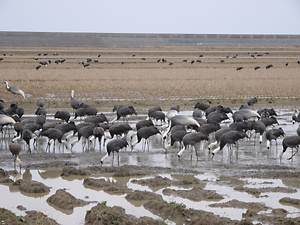
Hooded and White-naped Cranes
Because we were still near the airport we had a early start in our rather small vehicle. Driver and passenger in the front, three of us in the middle and two in the back, blocked in by the middle seats. We had quite a problem with misted windows for a lot of the morning. It was raining when we arrived in Izumi, an area of flat farmland, and we were soon seeing lots of cranes flying in the distance. We were soon out and watching hundreds of close Hooded and White-naped Cranes. Many had been attracted to food that had been put out for them but the whole feel of the place and the birds was of truly wild birds. Apparently amongst the hordes were a Common Crane, a Demoiselle Crane and a Sandhill Crane. Sadly no Siberian Cranes had turned up this year. Finding these individuals in such a large area and amongst 2000 White-naped and 9000 Hooded Cranes spread over a large area seemed difficult to say the least. However, our luck was in and helped by Pete Morris, who was leading a Birdquest trip but was nevertheless more than willing to point out birds to us, we soon had both the Common and the Demoiselle Crane on our list plus a bird that looked like a hybrid Common x Hooded Crane. No sign of the Sandhill though. Also taking advantage of the free food were Black-backed Wagtails, Oriental Greenfinches, Buff-bellied Pipits and Japanese Skylarks. We had a bonus in the form of a immature Red-crowned Crane, the first in this area for many years, and there was a Peregrine sitting in a field on a mud ridge. I am not sure what prey species it had in mind! We also had our first Cattle Egrets of the trip plus Little and Great Egrets and Grey Herons, all rather dwarfed by the cranes.
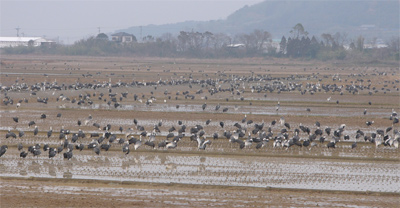
Hooded and White-naped Cranes
We then drove to another site that was good for cranes to see whether the Sandhill was there. It wasn't but we spent a while admiring hundreds if not thousands more of both Hooded and White-naped Cranes. A truly impressive spectacle.
We spent the rest of the day in this area, mostly working the fields but a couple of times checking nearby river mouths for gulls and waders. As well as the cranes we were hoping to see Daurian Jackdaw amongst the Rooks. There were hundreds of Rooks scattered about and during the day we checked them all. Alas, no Daurian Jackdaw. The fields gave us Oriental Turtle-doves (over 100 seen during the day), Eurasian Reed-buntings and Oriental Greenfinches. A short wet and muddy walk across a field added a few Common Snipe. A small bird seen feeding along a mud ridge turned out to be a male Chestnut-eared Bunting, soon to be joined by another male. A female Blue Rock-thrush was found by Graham as we drove along the concreted edge of the area, where it borders a river. The tide was in and the river held only a few Mallards, Northern Pintails and Eurasian Wigeons.
Next we drove to another river area where there are reed beds, small open pools, a mud-edged river and some scrubby bushes. Eurasian Reed-buntings were seen as was a Japanese Bush Warbler. I noticed some small birds in the most distant reeds and went back to the car to get my 'scope. A worthwhile trip since the small birds comprised a couple of Japanese White-eyes and our target species here, Chinese Penduline-tits. At least 12 of these birds were seen working their way along the edge of the reeds and back again. Also here we picked up Black-faced and Meadow Buntings. A little further up the road we went for a short walk. Peter was ahead of us by a few metres and suddenly beckoned urgently saying he'd just seen a pheasant and it had gone into the long grass in front of him. Fortunately for us the grass, although too deep to see the bird, was not extensive and bordered the river so the bird had nowhere to go except back towards us, which it did it typical pheasant way, exploding from the grass and flying over our heads. It was a male Green Pheasant and we were all very pleased to have run across this bird.
Time for another estuary and by now the tide had receded and there were birds to look at. On the shingley mud were gulls and ducks so up went the 'scopes and the grilling began. Black-tailed, Slaty-backed and Vega Gulls were quickly identified and some discussion was made of whether a couple of the birds were Heuglin's Gulls. We noted the features and later confirmed that they were indeed of that species. The ducks were entirely Eurasian Wigeon except for a single male American Wigeon that Graham found. Three Ospreys cruised over our heads and five Olive-backed Pipits were scared up from the grass by the path and flew off into nearby buildings.
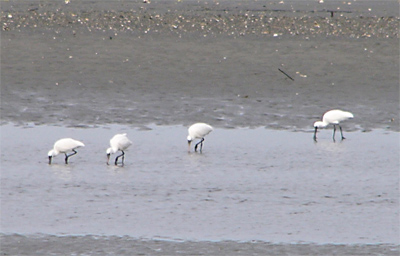
Black-faced Spoonbills
As the tide was now low, we checked another river and saw our first Common Kingfisher plus hundreds of Eurasian Wigeons. Then it was back to where we first started to ask about our other target species. We received positive news and were soon up on the concrete wall overlooking now-exposed mud. Immediately we all saw our target birds: four Black-faced Spoonbills. We marched a few hundred metres along the road, hidden by the concrete wall until we found a gap. 'Scopes up and we watched the four individuals of this rare species feeding and occasionally flying. We were all very pleased to have seen this species. Also in the immediate area were 3 Little Egrets, 16 Kentish Plovers and five Dunlins, and on the fields behind us we could see the Peregrine of this morning, a group of 16 Grey Herons and a Great Egret and Northern Lapwing.
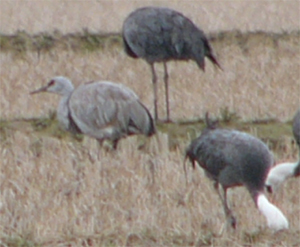
Sandhill Crane
Finally we drove back to the first crane site and we soon watching the Sandhill Crane – a six crane species day! I don't think there is anywhere else in the world that could happen.
The 11th February was our last day on Kyushu and we had two target species: Copper Pheasant and Japanese Murrelet. It was along drive to the mountainous region Armas thought we might get the pheasant. It's a lovely area with steep tree-covered slopes, the trees growing in patches of conifers, deciduous trees or bamboo. We stopped quite low down on one mountain to check a river valley and were rewarded with at least nine Yellow-throated Buntings and a male Grey Bunting. Peter found four White-bellied Green Pigeons flying over and a male and two female Mandarin were on the river. A little further up we stopped again and had a Crested Kingfisher. A stop by a roadworks traffic light was fortuitous. I looked out of the window and saw a raptor against the skyline. 'That looks interesting' I said and we piled out to check out the bird. It was a Mountain Hawk-eagle, a bird rumoured to soon to be split into its own species, Hodgson's Hawk-eagle. The bird disappeared behind the mountain after only two of us had seen it! We waited, watching where it had gone when I saw another bird to the right. 'Here's another one' I called and sure enough another Mountain Hawk-eagle was coming past. Then the first one reappeared. This was great – a hard to get bird and a future split. Could it get better? It did. Both settled on a tree on the skyline and we spent quite a while 'scoping these birds as they sat in the open apparently enjoying the morning sun.
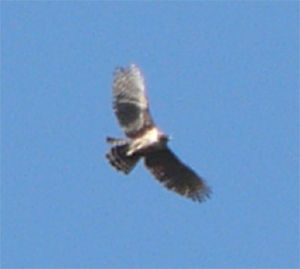
Mountain Hawk-eagle
Further up the mountain we stopped in a village and saw about 30 Yellow-throated Buntings, a Brown Dipper and yet another Mountain Hawk-eagle! The rest of the morning was spent 'safari birding' – driving quickly up a mountain road and down the other side to where Armas had seen one Copper Pheasant in December. Needless to say we were not lucky. Time was moving on so we headed for the coast. Unfortunately Armas did not have a site for Japanese Murrelet other than a place where he'd been shown one a few years before. We tried scanning various bits of water from various heights but did not find the sparrow-sized auk we sought. It was not a bird one lucks into without local knowledge, and we subsequently heard that the Birdquest group had enjoyed excellent views of up to 15 individuals. We did pick up more Yellow-throated and Black-faced Buntings, Blue Rock-thrushes (five males and a female) and our first and only Eastern Reef-egret of the tour. Now to Amami, although without Ian and Claire.

